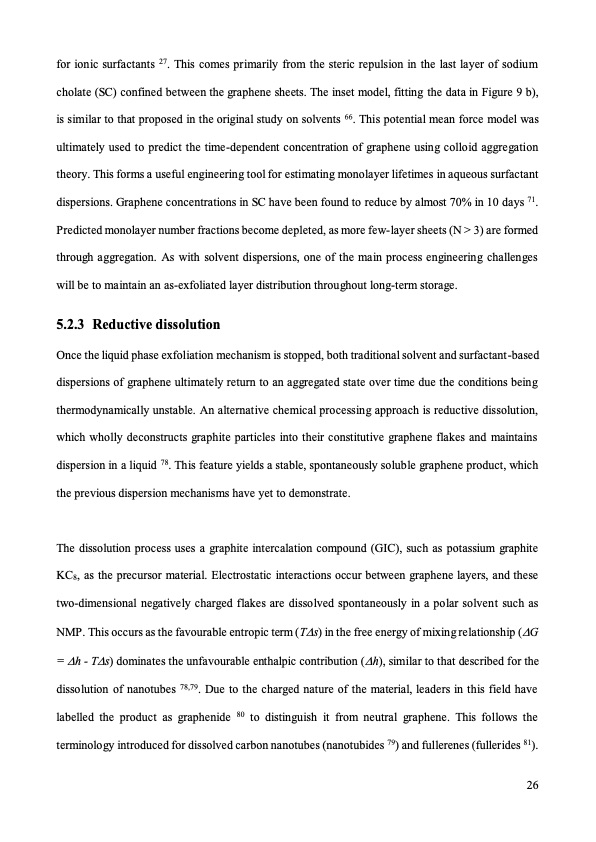PDF Publication Title:
Text from PDF Page: 026
for ionic surfactants 27. This comes primarily from the steric repulsion in the last layer of sodium cholate (SC) confined between the graphene sheets. The inset model, fitting the data in Figure 9 b), is similar to that proposed in the original study on solvents 66. This potential mean force model was ultimately used to predict the time-dependent concentration of graphene using colloid aggregation theory. This forms a useful engineering tool for estimating monolayer lifetimes in aqueous surfactant dispersions. Graphene concentrations in SC have been found to reduce by almost 70% in 10 days 71. Predicted monolayer number fractions become depleted, as more few-layer sheets (N > 3) are formed through aggregation. As with solvent dispersions, one of the main process engineering challenges will be to maintain an as-exfoliated layer distribution throughout long-term storage. 5.2.3 Reductivedissolution Once the liquid phase exfoliation mechanism is stopped, both traditional solvent and surfactant-based dispersions of graphene ultimately return to an aggregated state over time due the conditions being thermodynamically unstable. An alternative chemical processing approach is reductive dissolution, which wholly deconstructs graphite particles into their constitutive graphene flakes and maintains dispersion in a liquid 78. This feature yields a stable, spontaneously soluble graphene product, which the previous dispersion mechanisms have yet to demonstrate. The dissolution process uses a graphite intercalation compound (GIC), such as potassium graphite KC8, as the precursor material. Electrostatic interactions occur between graphene layers, and these two-dimensional negatively charged flakes are dissolved spontaneously in a polar solvent such as NMP. This occurs as the favourable entropic term (Ts) in the free energy of mixing relationship (G = h - Ts) dominates the unfavourable enthalpic contribution (h), similar to that described for the dissolution of nanotubes 78,79. Due to the charged nature of the material, leaders in this field have labelled the product as graphenide 80 to distinguish it from neutral graphene. This follows the terminology introduced for dissolved carbon nanotubes (nanotubides 79) and fullerenes (fullerides 81). 26PDF Image | graphene production via nonoxidizing liquid exfoliation

PDF Search Title:
graphene production via nonoxidizing liquid exfoliationOriginal File Name Searched:
Graphene-R2-review.pdfDIY PDF Search: Google It | Yahoo | Bing
Salgenx Redox Flow Battery Technology: Power up your energy storage game with Salgenx Salt Water Battery. With its advanced technology, the flow battery provides reliable, scalable, and sustainable energy storage for utility-scale projects. Upgrade to a Salgenx flow battery today and take control of your energy future.
CONTACT TEL: 608-238-6001 Email: greg@infinityturbine.com (Standard Web Page)